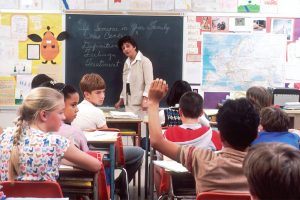What does teaching reading look like in your classroom?

There are four components that help me as a teacher to structure reading instruction in my classroom.
- Modelled Reading
- Shared Reading
- Guided Reading
- Independent Reading
These four components are woven into my weekly instruction to help my students work on different skills through their reading journey. To learn how I schedule my language arts blocks, read my article here.
The purpose behind the gradual release of responsibility is to ensure that students understand what they need to do. When we slowly show them how to do things and work on making the doing of the work more under their control then they are better prepared to show us the skills they have learned over time to master the concepts we are trying to teach them.
With this framework in reading it allows us as teachers to model much of the reading process explicitly to our students. Sharing with them the thinking skills and strategies of good readers. Especially when some will just figure it out and others are left with the mystery of what is actually happening.
Within this framework, I engage in all four of these activities each week.
So what happens in each of the four stages of instruction?
Let’s take a deeper look at these four stages and how they practically relate to everyday life in the classroom.


Modelled Reading involves the teacher showing students how to do something.
In reading, this means that the teacher is demonstrating for students how to read. The teacher is modelling how good readers read.
The teacher will choose a text. For many teachers, this really is a choice between a novel and a picture book. Personally, so that I have the ability to show my students a wider variety of reading genres I use picture books with my grade 4 and 5 students. These picture books lend themselves well to complex themes that I can review within a short time frame. They also help students to see and hear a wider variety of writing styles.
Before Teaching:
To prepare for your modelled reading portion of your lesson planning your first step will be to select a text.
You should always pre-read the text and while reading use sticky notes to mark places where you can
- ask questions
- make connections
- make inferences
- have students discuss a concept
- make a prediction
- analyze the author’s purpose or intent
- comment of adherence to text form.
You don’t need to do all of these in each book but focus on a few strategies that make sense for the text.
What you want to avoid is only focusing on one comprehension skill at a time and ignoring all others if they make sense. For many books, there may be a dominant focus on one comprehension strategy over another but I would avoid simply focusing on only one strategy since this is not something that would actually happen when students are authentically reading.
During Teaching
Allow students to sit close enough to you so that they can focus on the picture book. You may also allow them to bring their notebook to record their thoughts while reading. I wouldn’t, however, allow them to do other tasks not related to their reading skills (unless this is a clear strategy for those with an IEP)
Begin to read the book. Conduct the think-alouds that you have preplanned. However, you may want to skip a few so as to not stop the flow of reading. You want to focus on the key ideas of your own thinking and aim to stop once every 2-3 pages.
At important parts, you may also want to break up your own reading to give students a chance to turn and talk about the book. (sometimes I know it is time to do this when there begins to be a lot of chatter about the story as I am reading it)
I also think that because this process of stopping to explicitly share your thoughts when you are reading takes more time. I often can not spend longer than 20 minutes doing any one thing at a time. So, for this reason, I will often spread my read aloud over two or even possibly three days.
After Reading
I always leave the book out so that students can re-read it during independent reading activities. I also encourage some of my students to find the ‘YouTube version’ of the books I read so that they can listen to it. This helps students to practice what you did and re-reading a text is never a bad thing if it aids in better comprehension.
In this portion of the gradual release of responsibility model, the teacher is teaching alongside the students. The teacher is the one doing the work but the students are helping. Sometimes this may mean the students guide the teacher
Read a text three ways
- To Get the Gist
- To Understand the Purpose
- To Think Deeply
Guided reading
Not round-robin reading
- To focus on comprehension, fluency, and decoding
- To learn how to do something in a small group way – find evidence
- To learn how to be a good reader while the teacher guides you.
- To learn to love reading
- To share what they think about reading
Want to hear more from Patti? Check out her blog or find her on Facebook and Instagram!
